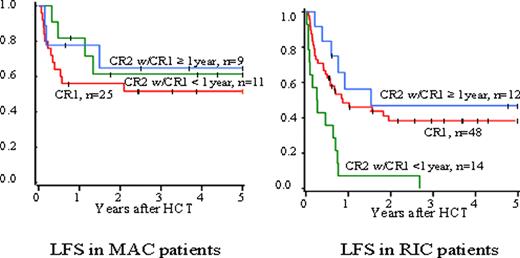Abstract
Abstract 3531
Reduced intensity conditioning (RIC) umbilical cord blood (UCB) transplantation is increasingly used in hematopoietic stem cell transplantation (HCT) for older and medically unfit patients. Data on the efficacy of HCT after RIC relative to myeloablative conditioning (MAC) are limited. We compared the outcomes of acute myeloid leukemia (AML) patients > 18 yrs who received UCB grafts after either RIC or MAC.
One hundred nineteen adult patients with AML in complete remission (CR) underwent an UCB transplant after RIC (n=74, 62%) or MAC (n=45, 38%) between January 2001 and December 2009. Conditioning was either reduced intensity and consisted of cyclophosphamide 50 mg/kg, fludarabine 200 mg/m2 and total body irradiation (TBI) 200 cGy or myelablative and consisted for cyclophosphamide 120 mg/kg, fludarabine 75mg/m2 and TBI 1200–1320cGy. All patients received cyclosporine (day -3 to day +180) and mycophenolate mofetil (day -3 to day +45) post-HCT immunosuppression and hematopoietic growth factor. Use of RIC was reserved for patients >45 years (n=37, 82%) or pre-existing severe co-morbidities (n=8, 18%). The two groups were similar except RIC had more preceding myelodysplastic syndrome (RIC=28% vs. MAC=4%, p<0.01) and older age (median, RIC=55yrs vs. MAC=33yrs; p<0.01). Remission status (CR1; RIC=65% vs. MAC=56%, p=0.9), CR1 duration ≥ 1 yr for CR2 HCT (RIC=46% vs. MAC=45% p=0.9) and the HCT-comorbidity index were similar (score >2; RIC=50% vs. MAC=40%, p=0.1). Furthermore, most patients received double UCB graft (RIC=85% vs. MAC=89%, p=0.5) with a maximum HLA disparity of 4/6 and 5/6 in 52% and 34% of RIC recipients vs. 62% and 29% of MAC recipients (p=0.5).
Median follow-up for survivors was 4.2 (RIC) and 3.5 years (MAC). The 3-year leukemia-free survival (LFS) was 31% vs. 55% (p=0.02) and 3-year relapse incidence was 43% vs. 9% (p<0.01) in recipients of RIC and MAC, respectively (Figure). One-year transplant related mortality (TRM) was similar (RIC=16% vs. MAC=24%; p=0.55). In multivariate analysis (Table), RIC recipients and those in CR2 with short CR1 duration had higher risk of relapse and poorer LFS. No factors predicted TRM.
Kaplan-Meier estimates of leukemia free survival (LFS) by disease status at HCT
Kaplan-Meier estimates of leukemia free survival (LFS) by disease status at HCT
Multivariate analysis of outcomes
| Outcome measure . | Relative risk . | 95% CI . | p . |
|---|---|---|---|
| Relapse incidence | |||
| RIC vs. MAC | 4.7 | 2.0–10.4 | <0.01 |
| CR1 | 1.00 | ||
| CR2 w/ CR1< 1 yr | 1.9 | 1.0–3.8 | 0.06 |
| CR2 w/ CR1>=1 yr | 0.5 | 0.2–1.5 | 0.2 |
| Leukemia free survival | |||
| RIC vs. MAC | 2.3 | 1.3–4.0 | <0.01 |
| CR1 | 1.00 | ||
| CR2 w/ CR1< 1 yr | 1.9 | 1.1–3.4 | 0.03 |
| CR2 w/ CR1>=1 yr | 0.7 | 0.3–1.4 | 0.33 |
| Outcome measure . | Relative risk . | 95% CI . | p . |
|---|---|---|---|
| Relapse incidence | |||
| RIC vs. MAC | 4.7 | 2.0–10.4 | <0.01 |
| CR1 | 1.00 | ||
| CR2 w/ CR1< 1 yr | 1.9 | 1.0–3.8 | 0.06 |
| CR2 w/ CR1>=1 yr | 0.5 | 0.2–1.5 | 0.2 |
| Leukemia free survival | |||
| RIC vs. MAC | 2.3 | 1.3–4.0 | <0.01 |
| CR1 | 1.00 | ||
| CR2 w/ CR1< 1 yr | 1.9 | 1.1–3.4 | 0.03 |
| CR2 w/ CR1>=1 yr | 0.7 | 0.3–1.4 | 0.33 |
UCB with RIC extends the use of allogeneic HCT for older and less fit patients with limited TRM. However, the increased relapse risk and poorer LFS in the RIC setting indicates the need for novel strategies to improve leukemia control post-transplantation, especially in CR2 patients with short CR1 duration.
Wagner:CORD:USE: Membership on an entity's Board of Directors or advisory committees; VidaCord: Membership on an entity's Board of Directors or advisory committees. Weisdorf:Genzyme: Research Funding; Hospira.
Author notes
Asterisk with author names denotes non-ASH members.


This feature is available to Subscribers Only
Sign In or Create an Account Close Modal